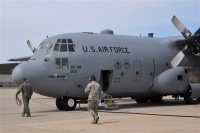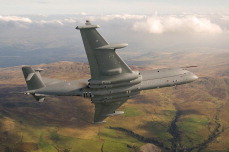WASHINGTON, April 30, 2010 — Defense Secretary Robert M. Gates has authorized two Air Force Reserve C‑130H aircraft to support the response to a massive oil slick that threatens wetlands and beaches along the Gulf Coast, Pentagon Press Secretary Geoff Morrell confirmed today.
In addition, the Navy has dispatched 66,000 feet of inflatable oil boom with anchoring equipment, along with seven skimming systems and their supporting gear to the region, Navy Lt. Myers Vasquez reported.
The C130 crews, assigned to the 910th Airlift Wing’s 757th Airlift Squadron at the Youngstown Air Reserve Station in Ohio, had prepositioned in Mississippi in anticipation of the tasking.
“We are posturing to be ready to provide support to the ongoing emergency efforts if called upon,” said Air Force Col. Craig Peters, the 910th Operations Group commander. Weather currently is hampering the aircraft from operating, Morrell said, but flights could begin as soon as tomorrow. The aircraft are equipped with Modular Aerial Spray Systems used for aerial spray missions, Air Force Master Sgt. Bob Barko Jr., the wing’s public affairs superintendent, told American Forces Press Service.
They are expected to be called on to help disperse the oil slick in accordance with a 1996 memo of understanding between the Air Force and Coast Guard, Air Force officials said. The 910th is home to the only full-time, fixed-wing, large-area aerial spray unit within the Department of Defense. The unit conducts spray missions at military installations and their surrounding communities, primarily to control biting insects as well as vegetation growth on bombing ranges, Barko said.
However, tests conducted between 1992 and 1994 at the Coast Guard’s request demonstrated the unit’s capability to apply dispersing materials to oil slicks, such as the one currently threatening the Gulf Coast.
The aerial spray unit trains for this mission, most recently, during a multi-agency international exercise in Brownsville, Texas, in 2008, Barko said.
“This is a situation we have trained for — for years,” Barko said of the Gulf mission. “To have the opportunity to do it in the real world and help folks along the Gulf Coast with this capability is really gratifying for everyone involved.”
The Navy equipment, along with 50 civilian operators and maintainers contracted through Naval Sea Systems Command, began arriving yesterday in Gulfport, Miss., from Williamsburg, Va., and Port Hueneme, Calif., Vasquez reported.
The equipment was quickly moved to the Mississippi state dock near Gulfport and put in use at the direction of the federal on-scene coordinator, he said.
Source:
U.S. Department of Defense
Office of the Assistant Secretary of Defense (Public Affairs)

 von
von 
